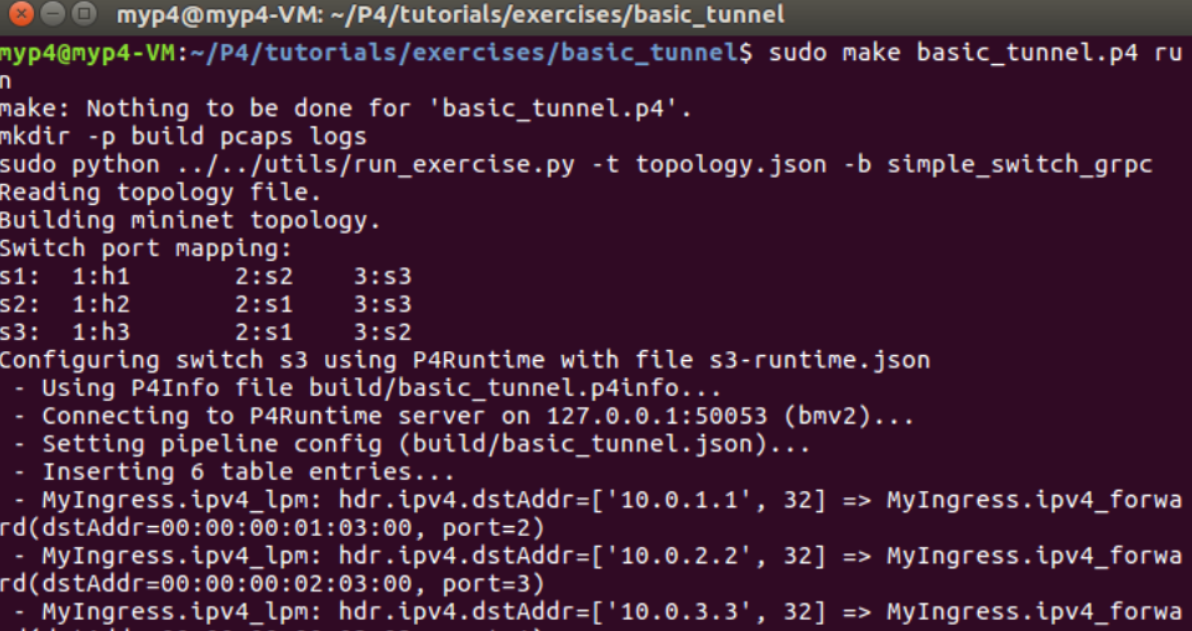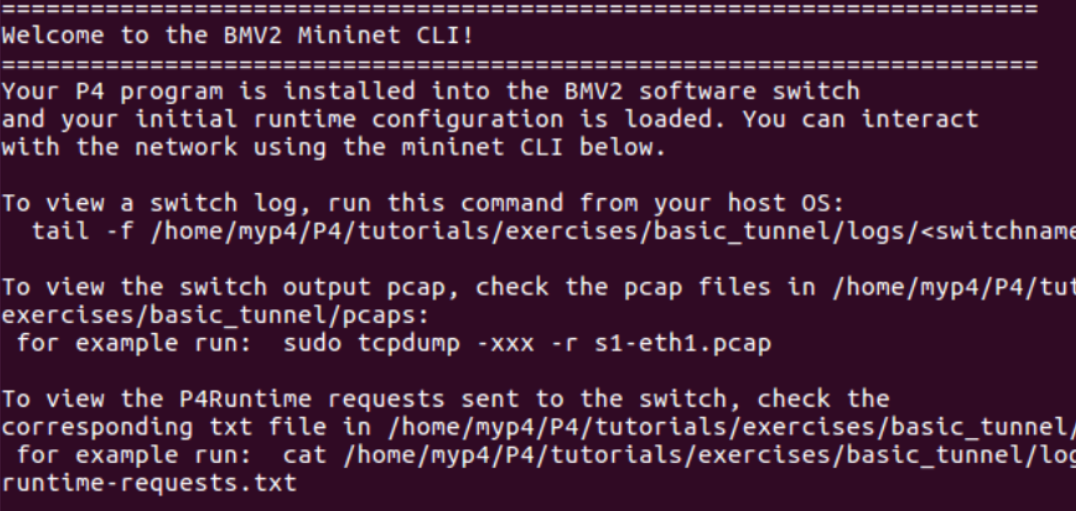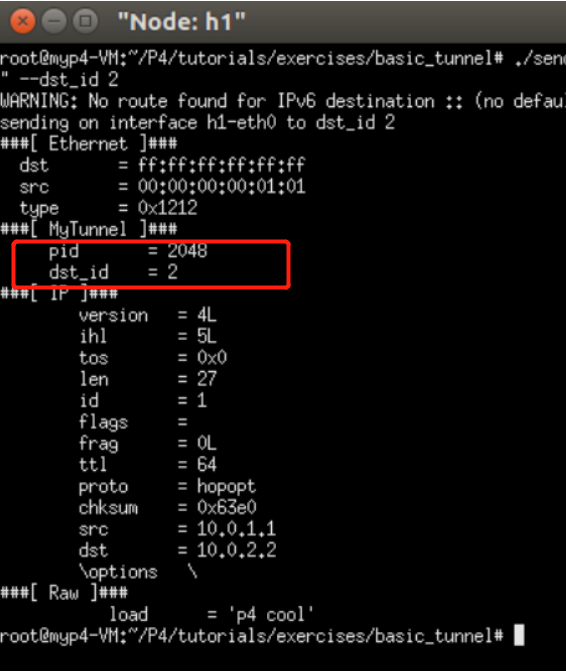实验8:数据平面可编程实践——P4
实验8:数据平面可编程实践——P4
一、实验目的
掌握V1Model框架下P4_16的程序结构和基本语法
能够运用 P4 进行简单数据平面编程
二、实验环境
下载虚拟机软件Oracle VisualBox或VMware;
在虚拟机中安装Ubuntu 16.04 Desktop amd64,并安装完整Mininet和P4开发环境;
提供P4镜像P4-Suite2018.ova,提取码:egwf
三、实验要求
学习P4官方示例教程,链接:https://github.com/p4lang/tutorials,了解P4-16版本的基本语法、基于V1Model的P4代码结构,完成如下练习:
(一)基本要求
熟悉使用P4实现交换机IPv4的基本转发原理,编写P4程序,在下面的拓扑中实现IPV4 隧道转发。
1.运行basic_tunnel.p4


2.pingall(当前都是能通的)

3.打开 h1 h2 终端

4.无隧道

5.有隧道:--dst_id 2

(二)进阶要求
在熟悉隧道转发原理的前提下,编写实现P4Runtime的Python代码,将流规则下发到上图拓扑中的交换机,实现依据此规则的隧道转发。
1.
2.修改成下面代码运行
点击查看代码
#!/usr/bin/env python3
import argparse
import grpc
import os
import sys
from time import sleep
# Import P4Runtime lib from parent utils dir
# Probably there's a better way of doing this.
sys.path.append(
os.path.join(os.path.dirname(os.path.abspath(__file__)),
'../../utils/'))
import p4runtime_lib.bmv2
from p4runtime_lib.switch import ShutdownAllSwitchConnections
import p4runtime_lib.helper
SWITCH_TO_HOST_PORT = 1
SWITCH_TO_SWITCH_PORT = 2
def writeTunnelRules(p4info_helper, ingress_sw, egress_sw, tunnel_id,
dst_eth_addr, dst_ip_addr):
"""
Installs three rules:
1) An tunnel ingress rule on the ingress switch in the ipv4_lpm table that
encapsulates traffic into a tunnel with the specified ID
2) A transit rule on the ingress switch that forwards traffic based on
the specified ID
3) An tunnel egress rule on the egress switch that decapsulates traffic
with the specified ID and sends it to the host
:param p4info_helper: the P4Info helper
:param ingress_sw: the ingress switch connection
:param egress_sw: the egress switch connection
:param tunnel_id: the specified tunnel ID
:param dst_eth_addr: the destination IP to match in the ingress rule
:param dst_ip_addr: the destination Ethernet address to write in the
egress rule
"""
# 1) Tunnel Ingress Rule
table_entry = p4info_helper.buildTableEntry(
table_name="MyIngress.ipv4_lpm",
match_fields={
"hdr.ipv4.dstAddr": (dst_ip_addr, 32)
},
action_name="MyIngress.myTunnel_ingress",
action_params={
"dst_id": tunnel_id,
})
ingress_sw.WriteTableEntry(table_entry)
print("Installed ingress tunnel rule on %s" % ingress_sw.name)
# 2) Tunnel Transit Rule
# The rule will need to be added to the myTunnel_exact table and match on
# the tunnel ID (hdr.myTunnel.dst_id). Traffic will need to be forwarded
# using the myTunnel_forward action on the port connected to the next switch.
#
# For our simple topology, switch 1 and switch 2 are connected using a
# link attached to port 2 on both switches. We have defined a variable at
# the top of the file, SWITCH_TO_SWITCH_PORT, that you can use as the output
# port for this action.
#
# We will only need a transit rule on the ingress switch because we are
# using a simple topology. In general, you'll need on transit rule for
# each switch in the path (except the last switch, which has the egress rule),
# and you will need to select the port dynamically for each switch based on
# your topology.
# TODO build the transit rule
# TODO install the transit rule on the ingress switch
table_entry = p4info_helper.buildTableEntry(
table_name="MyIngress.myTunnel_exact",
match_fields={
"hdr.myTunnel.dst_id": tunnel_id
},
action_name="MyIngress.myTunnel_forward",
action_params={
"port": SWITCH_TO_SWITCH_PORT
})
ingress_sw.WriteTableEntry(table_entry)
print("Installed transit tunnel rule on %s" % ingress_sw.name)
# 3) Tunnel Egress Rule
# For our simple topology, the host will always be located on the
# SWITCH_TO_HOST_PORT (port 1).
# In general, you will need to keep track of which port the host is
# connected to.
table_entry = p4info_helper.buildTableEntry(
table_name="MyIngress.myTunnel_exact",
match_fields={
"hdr.myTunnel.dst_id": tunnel_id
},
action_name="MyIngress.myTunnel_egress",
action_params={
"dstAddr": dst_eth_addr,
"port": SWITCH_TO_HOST_PORT
})
egress_sw.WriteTableEntry(table_entry)
print("Installed egress tunnel rule on %s" % egress_sw.name)
def readTableRules(p4info_helper, sw):
"""
Reads the table entries from all tables on the switch.
:param p4info_helper: the P4Info helper
:param sw: the switch connection
"""
print('\n----- Reading tables rules for %s -----' % sw.name)
for response in sw.ReadTableEntries():
for entity in response.entities:
entry = entity.table_entry
# TODO For extra credit, you can use the p4info_helper to translate
# the IDs in the entry to names
table_name = p4info_helper.get_tables_name(entry.table_id)
print('%s: ' % table_name, end=' ')
for m in entry.match:
print(p4info_helper.get_match_field_name(table_name, m.field_id), end=' ')
print('%r' % (p4info_helper.get_match_field_value(m),), end=' ')
action = entry.action.action
action_name = p4info_helper.get_actions_name(action.action_id)
print('->', action_name, end=' ')
for p in action.params:
print(p4info_helper.get_action_param_name(action_name, p.param_id), end=' ')
print('%r' % p.value, end=' ')
print()
def printCounter(p4info_helper, sw, counter_name, index):
"""
Reads the specified counter at the specified index from the switch. In our
program, the index is the tunnel ID. If the index is 0, it will return all
values from the counter.
:param p4info_helper: the P4Info helper
:param sw: the switch connection
:param counter_name: the name of the counter from the P4 program
:param index: the counter index (in our case, the tunnel ID)
"""
for response in sw.ReadCounters(p4info_helper.get_counters_id(counter_name), index):
for entity in response.entities:
counter = entity.counter_entry
print("%s %s %d: %d packets (%d bytes)" % (
sw.name, counter_name, index,
counter.data.packet_count, counter.data.byte_count
))
def printGrpcError(e):
print("gRPC Error:", e.details(), end=' ')
status_code = e.code()
print("(%s)" % status_code.name, end=' ')
traceback = sys.exc_info()[2]
print("[%s:%d]" % (traceback.tb_frame.f_code.co_filename, traceback.tb_lineno))
def main(p4info_file_path, bmv2_file_path):
# Instantiate a P4Runtime helper from the p4info file
p4info_helper = p4runtime_lib.helper.P4InfoHelper(p4info_file_path)
try:
# Create a switch connection object for s1 and s2;
# this is backed by a P4Runtime gRPC connection.
# Also, dump all P4Runtime messages sent to switch to given txt files.
s1 = p4runtime_lib.bmv2.Bmv2SwitchConnection(
name='s1',
address='127.0.0.1:50051',
device_id=0,
proto_dump_file='logs/s1-p4runtime-requests.txt')
s2 = p4runtime_lib.bmv2.Bmv2SwitchConnection(
name='s2',
address='127.0.0.1:50052',
device_id=1,
proto_dump_file='logs/s2-p4runtime-requests.txt')
# Send master arbitration update message to establish this controller as
# master (required by P4Runtime before performing any other write operation)
s1.MasterArbitrationUpdate()
s2.MasterArbitrationUpdate()
# Install the P4 program on the switches
s1.SetForwardingPipelineConfig(p4info=p4info_helper.p4info,
bmv2_json_file_path=bmv2_file_path)
print("Installed P4 Program using SetForwardingPipelineConfig on s1")
s2.SetForwardingPipelineConfig(p4info=p4info_helper.p4info,
bmv2_json_file_path=bmv2_file_path)
print("Installed P4 Program using SetForwardingPipelineConfig on s2")
# Write the rules that tunnel traffic from h1 to h2
writeTunnelRules(p4info_helper, ingress_sw=s1, egress_sw=s2, tunnel_id=100,
dst_eth_addr="08:00:00:00:02:22", dst_ip_addr="10.0.2.2")
# Write the rules that tunnel traffic from h2 to h1
writeTunnelRules(p4info_helper, ingress_sw=s2, egress_sw=s1, tunnel_id=200,
dst_eth_addr="08:00:00:00:01:11", dst_ip_addr="10.0.1.1")
# TODO Uncomment the following two lines to read table entries from s1 and s2
readTableRules(p4info_helper, s1)
readTableRules(p4info_helper, s2)
# Print the tunnel counters every 2 seconds
while True:
sleep(2)
print('\n----- Reading tunnel counters -----')
printCounter(p4info_helper, s1, "MyIngress.ingressTunnelCounter", 100)
printCounter(p4info_helper, s2, "MyIngress.egressTunnelCounter", 100)
printCounter(p4info_helper, s2, "MyIngress.ingressTunnelCounter", 200)
printCounter(p4info_helper, s1, "MyIngress.egressTunnelCounter", 200)
except KeyboardInterrupt:
print(" Shutting down.")
except grpc.RpcError as e:
printGrpcError(e)
ShutdownAllSwitchConnections()
if __name__ == '__main__':
parser = argparse.ArgumentParser(description='P4Runtime Controller')
parser.add_argument('--p4info', help='p4info proto in text format from p4c',
type=str, action="store", required=False,
default='./build/advanced_tunnel.p4.p4info.txt')
parser.add_argument('--bmv2-json', help='BMv2 JSON file from p4c',
type=str, action="store", required=False,
default='./build/advanced_tunnel.json')
args = parser.parse_args()
if not os.path.exists(args.p4info):
parser.print_help()
print("\np4info file not found: %s\nHave you run 'make'?" % args.p4info)
parser.exit(1)
if not os.path.exists(args.bmv2_json):
parser.print_help()
print("\nBMv2 JSON file not found: %s\nHave you run 'make'?" % args.bmv2_json)
parser.exit(1)
main(args.p4info, args.bmv2_json)
结果:
总结:总体还是有难度的:对于从https://github.com/p4lang/tutorials代码带进去一直出错,说实话没有耐心是做不出来的,把我整崩溃了都,很多错误都参考请教了同学。特别是关于 这个错误还是很头疼的,最后还是请教了同学才解决成功,特别是刚刚就开始vi命令,然后由于个人原因强行关闭了导致出现什么两个同属性文字不能同存。真的头疼,也是做了好久才做出来的。不过代码基本都是参考的链接中的代码。就是生搬硬敲。当然对于内容还是看懂的。
这个错误还是很头疼的,最后还是请教了同学才解决成功,特别是刚刚就开始vi命令,然后由于个人原因强行关闭了导致出现什么两个同属性文字不能同存。真的头疼,也是做了好久才做出来的。不过代码基本都是参考的链接中的代码。就是生搬硬敲。当然对于内容还是看懂的。



 浙公网安备 33010602011771号
浙公网安备 33010602011771号